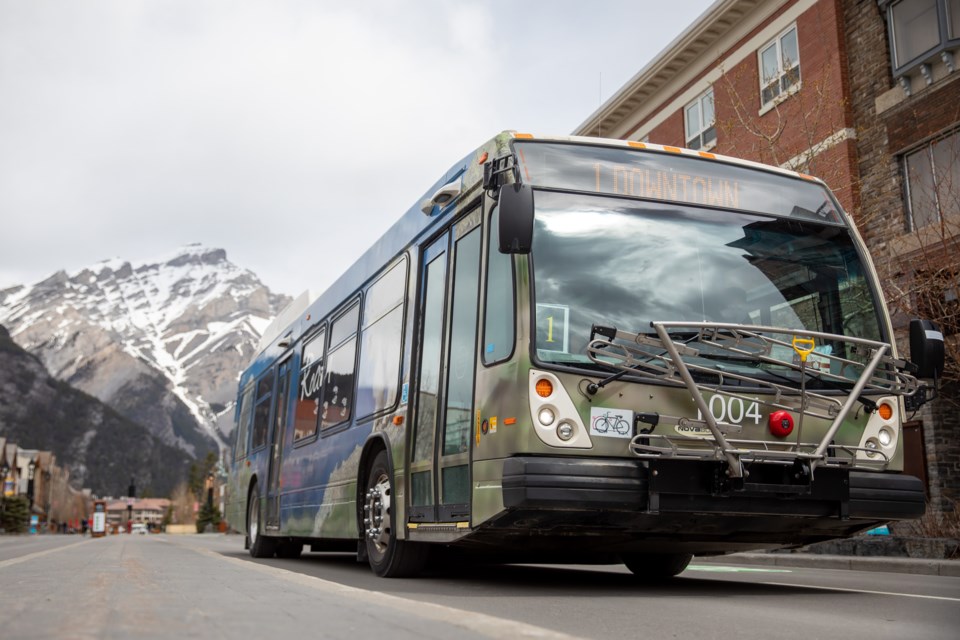CANMORE – A focus on achieving a 10 per cent increase in ridership over 2019 levels will be a goal for Roam Transit as it heads into 2022.
With hopes of rebounding from the impact of the COVID-19 pandemic, the Bow Valley Regional Transit Services Commission approved the operating and capital budget for the valley bus system at its final meeting prior to the municipal election.
“We’re hoping to achieve about 10 per cent above the 2019 levels,” said Martin Bean, Roam Transit’s CAO. “The caveat on that is dependant on the visitor population coming back strongly and that’s unknown with COVID-19 restrictions and the general comfort with travelling.
“We start to plan towards our hiring and service levels to meet those needs and the anticipation now is the demand for transit will continue to grow and get back on the path we were on prior to COVID, which is fairly significant growth each year.”
The transit service is popular among locals for getting around the valley, but tourists have also come to rely on routes in getting around and avoiding the costs that come with vehicles such as parking and fuel.
The public health restrictions at various points of the pandemic have significantly impacted the bottom line of transit services across Canada, but without the large numbers of tourists using the system, Roam saw a drastic cutback in ridership the past two years.
An operating budget was approved for about $6.7 million next year after the draft budget had previously been agreed at their August meeting.
The primary expenses are wages and benefits at about $3.93 million, vehicle expenses of $1.35 million and fuel costing about $645,000.
The commission also approved the additions of a full-time human resources coordinator due to the transit service continuing to expand, especially in the spring and summer months. A part-time dispatch coordinator – who would be dispatch 40 per cent of the time and 60 per cent driving – was approved, with the salary split between Roam and Parks Canada.
The budget is estimating revenue prior to requisitions of roughly $3 million, with $1.8 estimated to come from the farebox revenue and $600,000 from pass sales.
When requisitions are included from partnering municipalities and Parks Canada, the total income is about $7.3 million. It is estimated a surplus of $526,000 will remain at the end of 2022.
The projected income for 2023 is $7.5 million compared to an operating budget potentially at $6.9 million and estimated income of $7.6 million in 2024 and operating costs forecasted at $7.05 million.
This past summer saw Roam introduce a reservation system on more popular tourism routes in Banff National Park such as Johnston Canyon and Lake Louise.
Bean said administration will return with a report to the commission in December, but the early signs have shown it was a success. The program saw 75 per cent of seats available for reservation and the remainder for walk-up customers.
“We believe it was successful,” Bean said. “It was a high percentage of use of the reservation system and it just gave people comfort that they wouldn’t get to the bus and not have a seat, so they can plan their sightseeing trip a little more easily.”
Roam will continue to offer reservations on Route 8 between the Town of Banff and Lake Louise during the winter.
Roam Transit administration will also return by the end of 2022 with an update on its strategic plan for the commission. The goals for 2021 and 2022 were grouped together due to COVID-19 to allow for more time to complete and achieve goals.
The commission also received the Canadian Urban Transit Association national leadership award for environmental sustainability with its new building having been completed earlier this year.
The new operations and training centre facility was primarily funded through the province’s GreenTRIP program and is powered by a large solar array and has a net zero carbon design.
Bean said Roam will begin posting for summer positions around Christmas and New Year’s for jobs such as drivers, customer service staff and ambassadors for the coming summer.
He added training typically starts in March and takes about eight weeks for new drivers as winter staff compliment goes from about 35 to 40 to 75 to 80 in the summer.
In the municipal election, public transit was a significant talking point. While in other jurisdictions the topic can be more polarizing for residents, it has largely been embraced in the Bow Valley.
The partnership between the towns of Banff and Canmore and Improvement District No. 9 has largely been a success and seen the regional transit network expand.
“We’re happily able to connect the whole Bow Valley from the Canmore local service, the Banff local service, Canmore to Banff and all our routes to and around Lake Louise,” Bean said.




